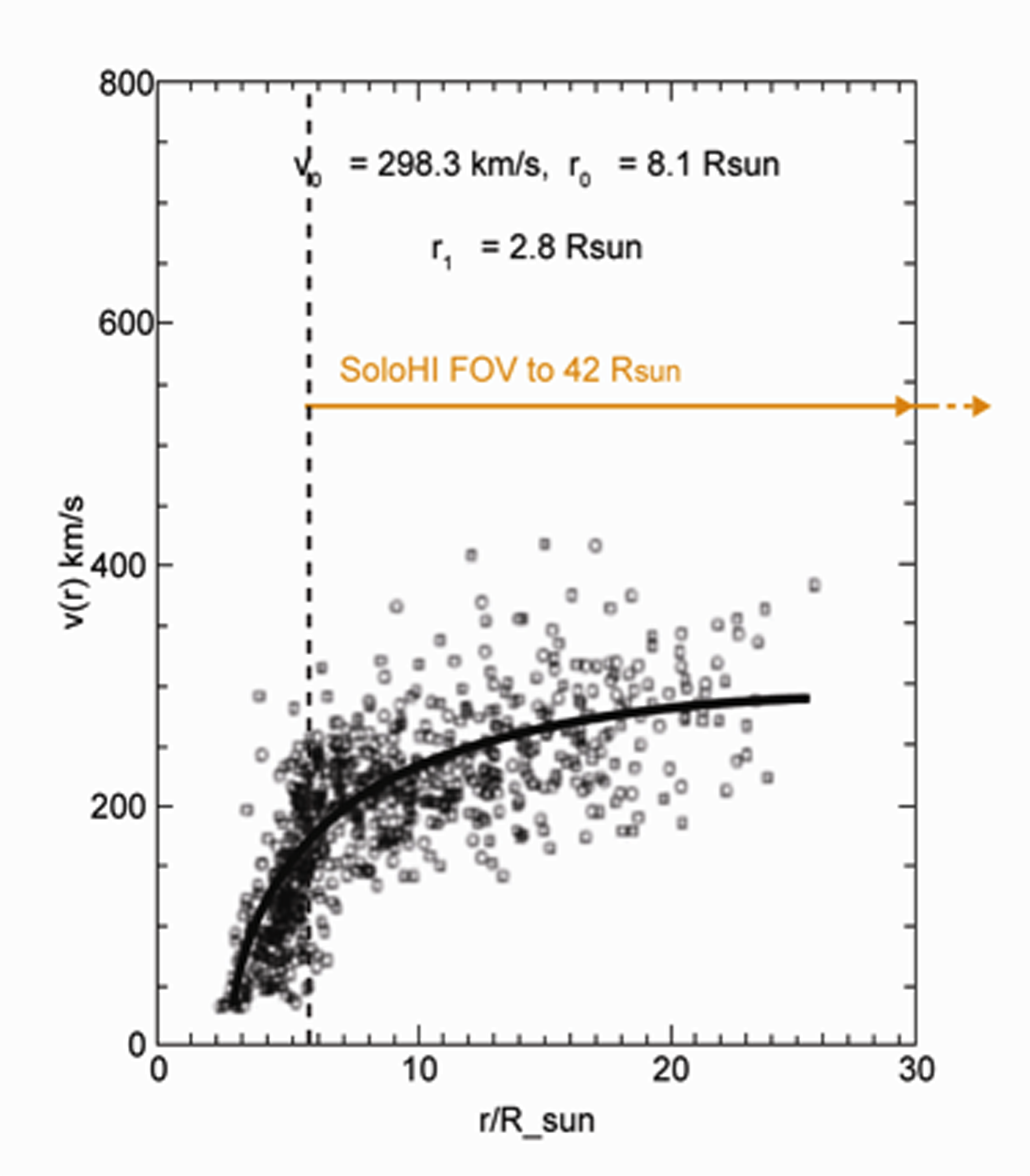Science Objectives
The Solar Orbiter mission aims to answer four main questions, referred to as science objectives, which are listed below (Müller et al. 2020). The SoloHI science investigation incorporates the mission objectives into its own science objectives.
– What drives the solar wind, and where does the coronal magnetic field originate?
– How do solar transients drive heliospheric variability?
– How do solar eruptions produce energetic particle radiation that fills the heliosphere?
– How does the solar dynamo work and drive connections between the Sun and the heliosphere?
The Solar Orbiter mission design is quite complex, involving perihelion and aphelion passages which do not always occur at the same heliocentric distance and/or with the same inclination relative to the ecliptic. For an imaging instrument such as SoloHI, these orbital variations imply both a changing FOV in terms of heliocentric coverage and varying spatial resolution, thus changing the optimum observing strategy and science focus for a given objective (e.g., shock formation vs. turbulence studies). A detailed description of each of these four mission objectives is discussed below.
1. What drives the solar wind?
A direct association has been made between the outward-flowing “blobs” and a corresponding inflow of “coronal rain” (Sanchez-Diaz et al. 2017), supporting the idea that “blobs” are the result of magnetic reconnection at the top of helmet streamers associated with the neutral line. While the reconnection sites will be observed with the Multi Element Telescope for Imaging and Spectroscopy (Metis; Antonucci et al. 2020) coronagraph and the Extreme Ultraviolet Imager (EUI; Rochus et al. 2020) in the inner corona, SoloHI observations are essential for measuring the outer coronal and heliospheric signatures of these events. During perihelion, SoloHI will be able to trace the streamer blobs formed in the Metis FOV to much greater heights. The large uninterrupted FOV of SoloHI enables more accurate velocity and mass measurements compared to LASCO or SECCHI, and the increased resolution and sensitivity of SoloHI will reduce the scatter in the velocity measurements at greater heliocentric distances shown in Figure 1.

Figure 1: Velocity measurements of streamer blobs with LASCO. The SoloHI FOV during perihelion passages is also shown. The three parameters at the top of the figure are the parameters in the fit shown as the solid line.
SoloHI will also enable the investigation of the structures that comprise the heliospheric plasma sheet (HPS) and their solar origins and the relation of the HPS to the heliospheric current sheet (HCS). For this, SoloHI will image the extension of streamer structures far into the heliosphere and enable comparison of their measured location and densities to in situ measurements and models. Observations from the STEREO/HI telescopes have shown that this is possible. SoloHI will have better sensitivity and spatial resolution than HI because it will fly closer and, in some cases, through the structures. This will allow tracing the HPS boundaries, their evolution, and their relation to the HCS in much greater detail than is possible with STEREO. When combined with the in situ observations from the Solar Orbiter and/or PSP, the SoloHI observations will provide strong constraints on the origin and evolution of the solar wind plasma in the heliosphere.
Observations of the scattered light intensity also enable measurements of the solar wind density turbulence (e.g., Marsch et al. 2000) directly from the SoloHI images. Because the observed emission is related to the number of electrons along the line of sight, intensity variations provide a direct measure of solar wind density variations, which can be compared to Earth-based interplanetary scintillation or PSP/Solar Orbiter in situ measurements.
2. How do solar transients drive heliospheric variability?
To understand the propagation and evolution of CMEs in the heliosphere, we have until recently relied on MHD models to fill in the gap between the imaging observations restricted to small elongations from the Sun and in situ measurements of interplanetary CMEs (ICMEs) at 1 AU. Since 2007, this gap has been filled by observations from the heliospheric imagers onboard STEREO. The SECCHI/HIs have imaged and tracked a variety of density structures such as ICMEs (Rouillard et al. 2009a), stream interaction regions (SIRs; Sheeley et al. 2008), and small flux ropes entrained in the SIRs (Rouillard et al. 2009b). We have found that CMEs rotate, deflect, and distort (Liewer et al. 2015; Isavnin et al. 2014; Nieves-Chinchilla et al. 2012), and interact with each other (e.g., Shen et al. 2013) in the inner heliosphere.
Somewhat surprisingly, the uninterrupted corona-to-heliosphere imaging from SECCHI has failed to answer many questions. The most glaring example is the lack of agreement between in situ and imaging-based reconstructions of CMEs (e.g., Wood et al. 2017). The speed profile, particularly of medium-speed (< 900 km s-1) ICMEs, is difficult to establish (Colaninno et al. 2013). The deformation of CMEs may be nothing more than projection effects (Nieves-Chinchilla et al. 2012). These problems arise partially from the difference in the spatial scales detected in situ and in the HIs and partially from the difference in the location of the measurements. Many events are difficult to track beyond the middle of the HI-1 FOV, above about 50–60 R⊙, for example. The long exposure times (20–60 min) and the use of running difference schemes to increase contrast obscure the fine structure within the ICMEs, making it harder to associate in situ and imaging features. Solar Orbiter and PSP offer an opportunity to solve some of these problems. SoloHI will extend the FOV of the SECCHI HI-1 to elongations greater than 40° from the Sun with increased sensitivity. It will also observe CMEs much closer to the Sun as they go over PSP (and Solar Orbiter), thus reducing the uncertainty between remote-sensing and in situ analyses due to evolution. The combination of WISPR, SoloHI, SOHO, and STEREO may observe the same CME from very different heliocentric distances and vantage points for the first time.
3. How do solar eruptions produce energetic particle radiation that fills the heliosphere?
The height of the formation of the shock, the 3D extent of the CME, and the existence or lack of a preceding event are necessary observations for a better understanding of the generation and propagation of solar energetic particles (SEPs). SoloHI can provide these crucial observations because it can image CMEs and their associated shocks at the coronal heights where the particles originate (≤10 R⊙) with a sufficient spatial resolution to resolve the CME-driven shock locations.
The optimal period for such observations is during perihelion passages. For example, at the minimum perihelion, the SoloHI FOV, for the standard observation mode, extends from 5.2 to 42 R⊙ with a resolution of 52 arcsec (AUeq; 1 AU equivalent) for half-resolution images. In other words, SoloHI is similar to a LASCO/C3 coronagraph with two times greater spatial resolution. SoloHI will readily observe and characterize the evolution of shocks. For example, a cadence of 30 min will allow six observations of a 2000 km s-1 CME in the SoloHI FOV during perihelion. The SoloHI inner FOV extends below 10 R⊙ for all heliocentric distances within 0.5 AU, contributing to the SEP analysis for a much larger part of the Solar Orbiter orbit than just at perihelion. For these parts of the orbit, SoloHI will be able to observe shocks and CMEs as they go over PSP or other heliospheric probes.
To address the spatial extent of the shocks, the SoloHI observations can be combined with simultaneous observations from the SECCHI coronagraphs and heliospheric imagers, WISPR, LASCO, or other near-Earth assets. The multipoint observations will be used to reconstruct the 3D structure of the CMEs and their associated shocks, as shown in Kwon & Vourlidas (2018).
4. What is the 3D structure of the heliosphere?
SoloHI will provide completely new information and constraints for understanding the 3D structure of the corona and CMEs. It will observe the heliosphere from out-of-ecliptic viewpoints at varying latitudes and heliocentric distances, thus providing strong constraints on the longitudinal extent of the structures. The Solar Orbiter-Sun distance plays an important role in the data analysis because it affects the visibility of the Thomson scattered features in the images. Xiong et al. (2018), and the references therein, have performed some interesting calculations, modeling the observations of such 3D structures from both ecliptic and out-of-the-ecliptic views. In essence, the varying distance acts as a filter, emphasizing structures that are progressively nearer the Thomson Surface (Vourlidas & Howard 2006) as it approaches the Sun. When combined with simultaneous white-light observations from another viewpoint (e.g. LASCO, STEREO, and/or PSP), the combined analysis should provide very strong constraints on the size of coronal features. The Solar Orbiter mission possesses another important advantage; within two weeks, the spacecraft sweeps between its two latitudinal extremes (i.e. southern and northern extremes), thus enabling tomographic reconstructions of streamers using the SoloHI data alone with the same temporal resolution achievable currently by the LASCO instrument.
SoloHI will be the first instrument to provide high-resolution imaging observations of Thomson-scattered emission from out of the ecliptic. SoloHI will be able to observe the interaction of the propagating CMEs with the solar wind and other CMEs from a unique vantage point. Depending on the inclination of the solar dipole during the high-latitude passes, SoloHI will be able to directly measure the longitudinal extent of the CME, the interaction of the CME with the boundaries of coronal holes, and the interaction between CMEs, through a shorter line of sight than is possible from the ecliptic. The shorter line of sight will minimize uncertainties in these measurements due to the effect of overlapping structures.
The connection between the in situ solar wind and its solar sources will be analyzed with Solar Orbiter measurements of solar wind speed, energy flux, magnetic field, chemical composition, and ionization state as functions of latitude. To get the full benefit of the out-of-ecliptic viewpoint in understanding the structure and dynamics of the corona, the SoloHI observations must be combined with the Metis, EUI, and SPICE (SPICE Consortium 2020) observations. Using the coronal imagers, we can observe the initiation and evolution of CMEs and more easily determine the spatial relation between CMEs and their coronal sources. At or near perihelion, when the SoloHI FOV enters the low corona, with Metis and EUI, we will be able to observe polar plumes and small-scale structures in the polar and equatorial coronal hole regions. SoloHI connects the in situ and solar surface measurements from Solar Orbiter in the inner heliosphere and the inner corona.
